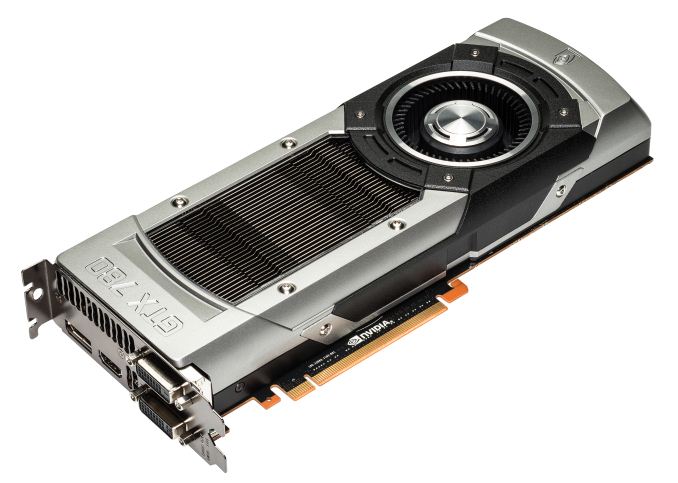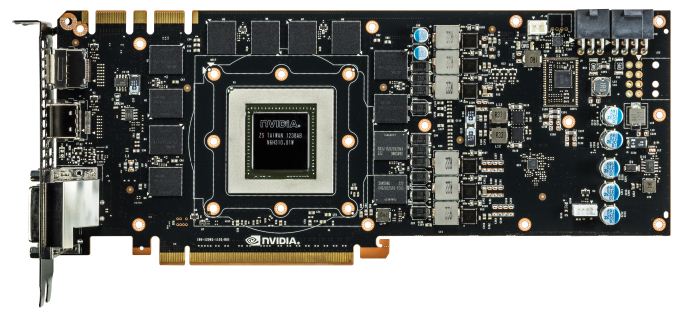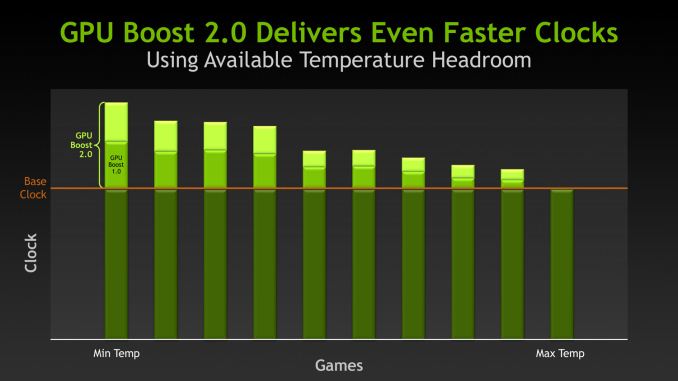NVIDIA GeForce GTX 780 Review: The New High End
by Ryan Smith on May 23, 2013 9:00 AM ESTMeet The GeForce GTX 780
As we previously mentioned, the GTX 780 is very much a Titan Mini in a number of ways. This goes for not only the architecture, features, and performance, but as it turns out it will be the case for the design too. For the reference GTX 780 NVIDIA will be straight-up reusing the GTX Titan’s board design, from the PCB to the cooler, and everything in between.
As a result the reference GTX 780 inherits all of the great things about the GTX Titan’s design. We won’t go into significant detail here – please read our GTX Titan review for a full breakdown and analysis of Titan’s design – but in summary this means we’re looking at a very well built blower design almost entirely constructed out of metal. GTX 780 is a 10.5” long card composed of a cast aluminum housing, a nickel-tipped heatsink, an aluminum baseplate, and a vapor chamber providing heat transfer between the GPU and the heatsink. The end result is that the reference GTX 780 like Titan before it is an extremely quiet card despite the fact that it’s a 250W blower design, while it also maintains the solid feel and eye-catching design of GTX Titan.
Drilling down, the PCB is also a re-use from Titan. It’s the same GK110 GPU mounted on the same PCB with the same 6+2 phase power design. This is part of the reason that GTX 780 has the same TDP as GTX Titan, while at the same time giving GTX 780 as much or more TDP headroom than Titan itself. Using the same PCB also means that GTX 780 has the same 6pin + 8pin power requirement and the same display I/O configuration of 2x DL-DVI, 1x HDMI, 1x DisplayPort 1.2.
Also being carried over from Titan is GPU Boost 2.0, which was first introduced there and has since been added to additional products (many GeForce 700M products already have it). GPU Boost is essentially a further min-maxed turbo scheme that more closely takes into account temperatures and GPU leakage characteristics to determine what boost bins can be used while staying below TDP. It’s more temperature dependent than the original GPU Boost and as a result more variable, but in cooler situations it allows tapping into that thermal headroom to hit higher clockspeeds and greater performance, TDP allowing. At the same time this means GTX 780 also gains GPU Boost 2.0’s temperature target functionality, which allows users to cap boost by temperature as well as TDP. As with Titan this limit is 80C by default, with the idea being that adjusting the limit is a proxy for adjusting the performance of the card and the amount of noise it generates.



















155 Comments
View All Comments
aidivn - Thursday, May 23, 2013 - link
so, how many Double Precision units are there in each SMX unit of gtx780? titan had 64 dp units in each of their SMX units which totaled to 896 dp unitsAnd can u turn them on or off from the forcewre driver menu like “CUDA – Double Precision” for gtx780?
Ryan Smith - Thursday, May 23, 2013 - link
Hardware wise this is GK110, so the 64 DP units are there. But most of them would be disabled to get the 1/24 FP64 rate.aidivn - Friday, May 24, 2013 - link
so how many are disabled and how many are enabled (numbers please)?Ryan Smith - Friday, May 24, 2013 - link
You would have only 1/8th enabled. So 8 per SMX are enabled, while the other 56 are disabled.aidivn - Saturday, May 25, 2013 - link
so, the GTX780 only has 96 DP units enabled while the GTX TITAN has 896 DP units enabled...thats a huge cut on double precisionDanNeely - Sunday, May 26, 2013 - link
That surprised me too. Previously the cards based on the G*100/110 cards were 1/8; this is a major hit vs the 580/480/280 series cards.Old_Fogie_Late_Bloomer - Thursday, May 23, 2013 - link
"GTX 780 on the other hand is a pure gaming/consumer part like the rest of the GeForce lineup, meaning NVIDIA has stripped it of Titan’s marquee compute feature: uncapped double precision (FP64) performance. As a result GTX 780 can offer 90% of GTX Titan’s gaming performance, but it can only offer a fraction of GTX Titan’s FP64 compute performance, topping out at 1/24th FP32 performance rather than 1/3rd like Titan."Seriously, this is just...it's asinine. Utterly asinine.
tipoo - Thursday, May 23, 2013 - link
Market segmentation is nothing new. The Titan really is a steal if you need DP, the next card up is 2400 dollars.Old_Fogie_Late_Bloomer - Thursday, May 23, 2013 - link
I'm well aware of the existence of market segmentation, but this is just ridiculous. Putting ECC RAM on professional cards is segmentation. Disabling otherwise functional features of hardware, most likely in the software drivers...that's just...ugh.SymphonyX7 - Thursday, May 23, 2013 - link
I just noticed that the Radeon HD 7970 Ghz Edition has been trouncing the GTX 680 in most of the benchmarks and trailing the GTX 680 in those benchmarks that traditionally favored Kepler. What the heck just happened? Didn't the review of the Radeon HD 7970 Ghz Edition say that it was basically tied with the GTX 680?